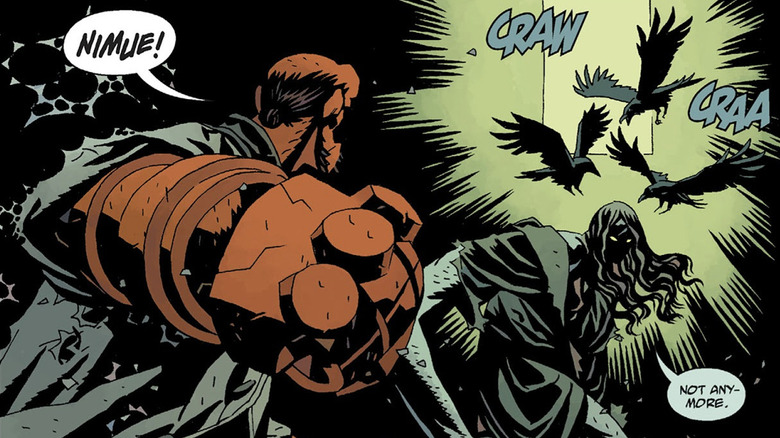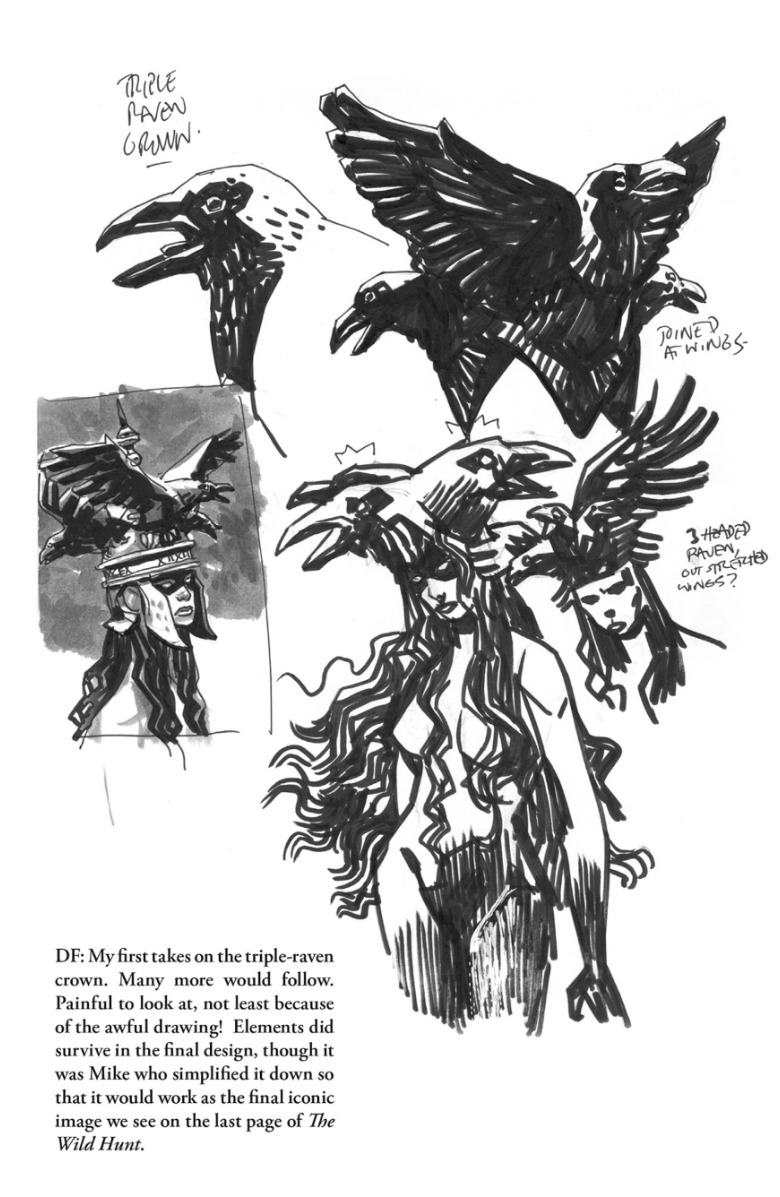The Biggest Challenge With The Best Hellboy Comics Wasn't What You Think
It's so hard to pick a favorite "Hellboy" story, whether comics or movies. The hero's signature tale is "The Corpse," a 25-page comic from 1996 drawn and plotted by Hellboy's creator Mike Mignola. In 1950s Ireland, Hellboy discovers a couple's baby has been swapped with a fairy named Gruagach. To get little Alice Monaghan back, the Sidhe dare Hellboy to bury a talking corpse in holy ground by sunrise.
This is the sort of spooky "occult investigator" story that Mignola intended "Hellboy" to be. He created Hellboy after drawing the Batman comic "Sanctum" (where Batman chases a criminal through a graveyard) and wanting to make more stories like that. But he didn't want to get complacent, either.
In 2001, Mignola concluded the "Hellboy" mini-series "Conqueror Worm" by having his hero leave the Bureau for Paranormal Research and Defense (BPRD). He wanted to shake things up by having Hellboy leave his "day job," and soon Mignola started pushing Hellboy into weirder and weirder fantasy stories.
That culminated in an epic trilogy of "Hellboy" mini-series from 2007 to 2011: "Darkness Calls," "The Wild Hunt," and "The Storm and the Fury." Written by Mignola and drawn by Duncan Fegredo, these three are my favorite "Hellboy" comics. While their apocalyptic scale seems removed from the low stakes of "The Corpse," the roots of this trilogy go back to that story.
The villain of the trilogy is an ancient English witch named Nimue, who was cut apart and scattered across the realm to prevent her evil from rising again. Then a vengeful Gruagach pieces her back together, asking only that she destroy Hellboy and the world of men. (The 2019 "Hellboy" movie retold Hellboy's battle with Nimue, but it lacked the comic's power.)
Over the story, Nimue's appearance changes. Initially, she is a pale and long-haired woman clad only in a red cloak. In "The Wild Hunt," she decides that she won't settle for being merely the Queen of Blood, but will instead be the Goddess of War. So, she discards a crown offered by one of her subjects and orders a new helmet forged, one made of three ravens named Badhbh, Macha, and Mor-Rioghain. (These are the three names of the Morrígan triad-deity from Irish mythology, which is associated with ravens and war.)
The final panel of "The Wild Hunt" is Nimue's raven helmet being forged:
It's an impressive design that lives up to the Blood Queen's demands, so of course she wears it in her final battle with Hellboy, right? Nope. Mignola and Fegredo struggled with designing the helmet and while they did crack the look, it still proved too burdensome to draw. So, they took the story in a different direction.
Designing Nimue's raven helmet was a challenge for Hellboy's Mike Mignola
"Hellboy" collected editions usually have generous offerings of concept art in the back pages. In "The Wild Hunt" and "The Storm and the Fury," you can see Fegredo's early sketches of Nimue and her helmet. The premise of the design — a battle helmet made from three metal ravens — never changed. Again, Nimue didn't pick three ravens because Mignola thought it would look cool, but because he wanted to invoke the Morrígan character.
The early concepts of the helmet were larger and more intricate. One has the three ravens with their wings spread outward; keeping track of the overlapping details on that would definitely be a pain to draw. Another has only three raven heads arranged in a circle, while another has the front raven with outspread wings and then two bird heads by its side. In one unused design, Fegredo tries to cut the knot by making it one raven with three heads.
A comic character's design can't just be a cool one-off drawing, it has to be something the artist can repeatedly render in panel after panel. That takes some innate simplicity, which these early drawings didn't achieve.
In the final design (which Fegredo credits to Mignola), the front-facing raven is hanging its wings straight down, which form the sides of the helmet; notice the wing patterns on the helmet pieces covering the sides of Nimue's face. The two side ravens then only have one wing each, but that still creates the idea that the helmet itself has two wings on opposite sides.
Fegredo calls the final look "simple and elegant," while he describes his own early drawings as "awful" and "painful to look at." (An unfair assessment — his Nimue drawings may have been too unwieldy for final designs but they still create an imposing villain.) Mignola, though, decided the helmet was still too big a pain:
"Ugh. The helmet. I'm pretty sure this one design gave Duncan and me more trouble than anything else in all our years working together. It gave us so much trouble that as soon as Nimue got that thing I was trying to figure out a way to get rid of it [...] I don't think either of us were sorry to see it go."
Since "The Wild Hunt" dramatically ended with the helmet's completion, Nimue couldn't just not wear it or switch her sense of style. Instead, Mignola found a way to remove the helmet that brought the story together with one last twist.
In "The Storm and the Fury," Hellboy strikes Nimue's head with the back of an axe. The helmet falls off and turns into three living ravens. The birds fly off and call out to Nimue's army, telling them to begin their war against mankind. Why does the helmet change its form? Because the wearer is no longer the Goddess of War.
Why Nimue becomes a dragon in Hellboy
Since the first "Hellboy" story — "Seed of Destruction" — the primary evil of the setting has been the Ogdru Jahad, seven primordial dragons locked away in a cosmic prison. If they're set free and return to Earth, it will unleash the apocalypse.
"The Wild Hunt" established that, before her defeat, Nimue had worshipped a "soul destroying black dragon." Speaking to Comic Book Resources in 2011, Mignola said he spent a lot of time trying to pin down the ending of "The Storm and the Fury." He then realized he could use Nimue's backstory to bring back the Ogdru Jahad, thereby tying the beginning and ending of "Hellboy" together (while also ditching Nimue's annoying-to-draw helmet).
During "The Storm and the Fury," as Nimue readies for conquest, one of her witch followers appears and tells her plans have changed; her masters have decided she will become their vessel. Nimue is aghast, unwilling to give herself up, but it doesn't matter.
When Hellboy reaches the top of Nimue's tower, the Blood Queen isn't there anymore. Instead, it's the Ogdru Jahad speaking through Nimue and as they fight Hellboy, they gradually transform their human vessel into a dragon. (See Mignola's concept art of that form below.)
One of the ravens, embodying Nimue's horror at the monster she's become, turns into a sword and falls into Hellboy's hand. By wielding that sword, he defeats the Blood Queen and holds back the tide of the Ogdru Jahad.
While a late addition to Hellboy's story, Nimue becomes one of his clearest foils. In "Darkness Calls," the witches of England first ask Hellboy to be their king. Being Hellboy, he tells them to take a hike, so Gruagach says they should revive Nimue instead. Both characters are also uniquely coded with the color red. "Hellboy" colorist Dave Stewart uses blue and yellow-tinted backgrounds throughout this trilogy, which means that Hellboy is always the center of your attention; there's no other red in the panels except his bright ruby red skin. Until Nimue, true to her title as the Queen of Blood, enters and is bathed in red colors too.
This final draconic turn makes Nimue into an even better counterpart to Hellboy. They're both harbingers of the apocalypse, and ones split between human and demon selves.
In "The Wild Hunt," Hellboy learns he is more human than he knew. His father was the demon lord Azzael, yes, but his mother was a human witch descended from King Arthur, and so Hellboy is too. He's both the Prince of Hell and the rightful King of England. If he chooses, he can lead the forces of the underworld against Nimue with a crown of flame upon his brow, or he can wield Excalibur and march the revived "noble dead" of England against her. He chooses neither, instead going into battle alone.
"Hellboy" has always been a story about destiny — and refusing it. Our hero was summoned to destroy the world, but he wants to live in it. During this trilogy, Hellboy's struggles have a more mundane form. In "The Mole," a prologue to "Darkness Calls," he dreams of his horned demon self erupting out of a mole on his hand. When he wakes up, he pours himself some drinks.
He keeps drinking until "The Storm and the Fury" — Hellboy has spent years being told he'll become a monster whether he wants to or not, and to cope with his fears he's surrendered himself to a different demon. Before he goes to face Nimue, he puts the bottle down. Until the very end, Hellboy chooses to be his own man and that man is a hero worthy of his royal lineage. After all, what is more classically heroic than slaying a dragon?









